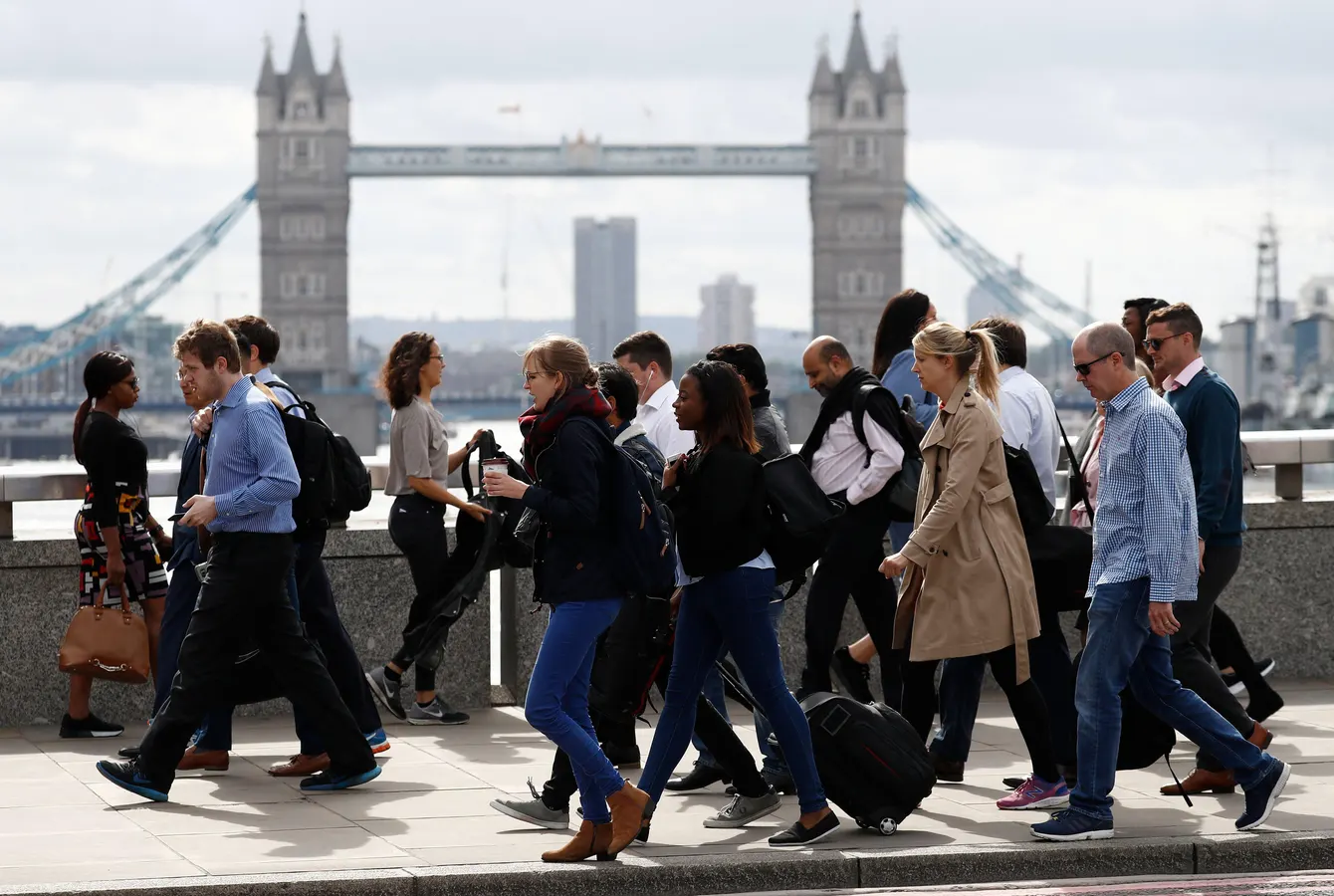By Contributor,Nicole Kobie,Odd Andersen
Copyright forbes

Commuters walk across London Bridge in London. (Photo by Odd ANDERSEN / AFP) (Photo by ODD ANDERSEN/AFP via Getty Images)
AFP via Getty Images
More of London’s roads should be handed over to pedestrians to help encourage even more walking — and the city could use wider pavements, less clutter, more benches, and even more toilets, too.
Those ideas were discussed last week by the London Assembly’s transport committee as it considered why walking rates have stagnated. Back in 2018, transport authority Transport for London (TfL) laid out a Walking Action Plan with the goal of making the UK capital “the world’s most walkable city”.
“The Plan aimed to increase the number of walking trips taken each day from 6.4 million to 7.5 million by 2024, but numbers have plateaued since 2019 and have hovered around 800,000 trips short of the target,” the assembly noted in a statement.
That suggests that something is discouraging Londoners from walking, which may come as a surprise to those outside the city as the British capital is widely seen as a haven for pedestrians — especially compared to some American cities. Some 39% of all trips by Londoners are already done by walking, according to TfL data.
One assembly member, Neil Garratt, pointed out that under the previous mayor, Boris Johnson, walking trips climbed from 5.8 million to 6.6 million — all before the TfL walking action plan. The current mayor, Sadiq Khan, took over in 2016. “So nearly a million over his term, and since the whole of Sadiq’s term, it’s increased by 0.11 million,” noted Garratt, who is a member of the same Conservative party as Johnson was.
MORE FOR YOU
What happened? The panel suggested two big shifts in behaviour: working patterns, and hence commutes, thanks to COVID lockdowns, and the rise of micromobility.
Lockdown stalled London’s walking
Two years after the TfL walking plan was unveiled, COVID hit and the UK entered a series of lockdowns that disrupted how people work. And, if people aren’t commuting, that impacts the number of trips taken, regardless of mode. (Indeed, though walking trips as a whole have stagnated, TfL has reported positive results in leisure walking and walking to school.)
Commuters wear face masks on the underground on January 04, 2023 in London, England. (Photo by Dan Kitwood/Getty Images)
Getty Images
Will Norman, Walking and Cycling Commissioner at TfL, pointed to a 70% drop in walking trips in 2020 that — like other forms of transport — still hasn’t returned to pre-pandemic levels. So far, across buses, the Underground and TfL’s other modes of transport, commuter travel remains about 90% that of prepandemic levels, and that matters for walking given half of all walking trips in London are to access public transport.
So the stalling walking figures fit a wider pattern, argued Norman. “Now, clearly that’s not all to do with the pandemic… but the fact that the same pattern is occurring in other modes of transport, as I indicated earlier, does imply that this is not just a walking issue that can sit at anyone’s feet,” said Norman.
Walking versus micromobility
In 2017, something else arrived suddenly to disrupt London’s walking ambitions: dockless bikes. “We had thousands of them descend on our streets overnight,” said Norman.
The suggestion is that the rise of such bikes led people use them for shorter rides, including to access other public transport, suggesting they may replace walking rather than other modes of transport.
Cyclists on 8th May 2025 in London, United Kingdom. Cycling is a very popular mode of transport in the capital as people try to avoid public transport, saving money, getting fit and saving time. (photo by Mike Kemp/In Pictures via Getty Images)
In Pictures via Getty Images
That’s also potentially true for the second-generation of dockless bikes, such as electric models from the likes of Lime and Forest, which began to roll out in 2018.
Tom Cohen, Senior Lecturer at the University of Westminster, said the modern crop of bikes have caused “a significant and lasting change” to how Londoners get around.
Ebikes disrupt walking through street clutter
Beyond that, micromobility also impacts walking rates by causing street clutter due to irresponsible parking, an ongoing issue that’s seen ideas mooted such as “virtual” docking bays; TfL has allocated £1.4 million to help roll out more bays this year.
Norman notes that parking is less of a problem with e-scooters, claiming there’s 90% compliance on parking in virtual bays because that form of micromobility is actually regulated — unlike e-bikes, where the government has been slow to legislate.
“Where you’ve got the bikes with none of those teeth, it is nowhere near that,” said Norman. “So it demonstrates that this really quite significant problem is manageable.”
Rental bikes are pictured scattered across a pavement on 26th February 2024 in London, United Kingdom. E-bikes left unsafely on pavements present hazards for pedestrians, in particular for disabled and elderly people. (photo by Mark Kerrison/In Pictures via Getty Images)
In Pictures via Getty Images
Assembly Member Caroline Russell suggested that parking for micromobility be moved off of sidewalks and onto roads — benefiting accessibility but also encouraging bikes and scooters to be ridden on the road, where they should be. Cohen agreed, saying it was worth ending the presumption that the pavement was where to leave bikes and scooters, and they should instead be on roads. “Apart from absolutely exceptional circumstances, that feels like a quick win,” he said.
Beyond e-bikes, the panel raised concerns around other forms of street clutter, which ranges from useful street furniture like benches and business signs to bin bags left out by businesses, large signs intended for cars, and so on.
Councillor Rezina Chowdhury, Vice Chair of the Transport and Environment Committee for London Councils noted that EV chargers were also impacting walkability, showing how transport with similar goals — in this case, addressing pollution and climate change — can have contradicting knock-on impacts too.
Take back the street for pedestrians
One answer could be taking back more of the roads for pedestrians. Existing guidance is that pavements should ideally be two meters in width, with a minimum of one meter allowable for up to six meters.
Cohen noted a double-wide buggy or mobility scooter is likely close to a meter wide. “Traversing that kind of channel for six meters would be… stressful at the best of times,” Cohen said. “If it’s a busy location where lots of people want to come the other way, it’s going to be downright unpleasant.”
Indeed, Rob Goodall, Associate Director for Global Active Travel Lead and Decarbonisation Expert at Arup suggested his employer’s own research suggested that people with reduced mobility struggled to get around in Central London because it was so busy. “People feel there’s a perception that they can’t be in those spaces because it’s so busy, and they don’t feel there’s enough space for them to move,” he said, adding that more space is given over to roads despite high pedestrian traffic in areas such as Soho.
Though, walkers naturally step into the road when they need more space. Goodall noted that in Soho at busy times, cars can’t get through because of the throngs of people — “it essentially pedestrianised itself.”
Indeed, some cities — Florence was noted — don’t ban cars. Instead, roads in busy central areas are for access rather than thoroughfares, with roads flexibly used by cars and pedestrians. That’s true, Cohen noted, of Covent Garden in London, where space constraints mean people frequently spill into the streets and cars naturally keep to a slower speed.
Tom Noble, project manager and urban designer at Create Streets, said road planning need not be binary — pro car or anti car. “It’s not just cars versus people,” he said. “You know, we can accommodate cars and people in the right way if we rebalance these things. It’s not just about banning one and the other. Treating cars as guests is an, I think, important approach.”
But if you want people to walk more, they’re going to need the space to do it — and the only real way to do that is clawing back space from roads, which take up disproportionate amounts of space in cities.
Cohen said: “The allocation of highway between motorised and non-motorised modes is something that we should not forget…. If we want to see Swiss levels of walking in London, that’s perhaps where we really need to go.”
“There’s an entrenched feeling that we can’t take away road space, except where it’s under utilised,” added Goodall, calling for authorities to be “a bit braver”.
Rest for walkability
Another way to encourage walking could be to offer seating or even toilets at regular intervals.
One report said benches should be every 50 metres — a bold move that would come with heavy costs to cover all of London — with a range of covered, shaded or open options depending on the weather.
A pedestrian sits on a bench in view of the Houses of Parliament in London, U.K., on Wednesday, Aug. 28, 2019. Photographer: Simon Dawson/Bloomberg
© 2019 Bloomberg Finance LP
Goodall noted that isn’t necessary for most able bodied people — who may simply be moving from one point to another — but those with mobility needs will need to rest frequently. The trick is balancing seating with pavement space, as well as cost considerations and avoiding encouraging antisocial behaviour.
That raises one issue with all of this: walking, and benches to rest, mean more people on the street — which some people inherently find threatening, with authorities using the spectre of anti-social behaviour as an excuse not to take action.
“Perhaps we can try to shift the general nature of our debate to be more accepting of and embracing of the presence of people on the street — you know, Jane Jacobs wants us to be on the street looking after one another,” said Cohen.
“It does drive me a bit crazy when we talk about anti-social behaviour all the time and we end up throwing out all sorts of normal social behaviour,” added Noble.
Spend a penny for pedestrian toilets
Another issue is toilets. Want people to walk to work? If it’s significantly longer than taking the train, they may require access to a toilet on the way.
Public toilet, London, UK Public toilets should be seen as a serious core component in both strategic urban policy and local area design They are valuable townscape features in their own right as manifestation civic pride and good urban design. (Photo by BuildPix/Construction Photography/Avalon/Getty Images)
Getty Images
Assembly Member Russell raised the issue of a lack of public toilets impacting walkability, especially among older people, but Cohen noted the high costs meant it was unlikely to win public funding.
“I can say with some confidence that without a significant change to the way in which we do business cases, it will continue to look like poor value for money,” he said.
But Cohen noted: “We do find substantial sums to invest in certain things in transport terms, therefore we could be asking ourselves whether we’re making the best decisions.”
Chowdhury added that there’s just not enough money to cover off all the areas people would like to see. “You know, there’s political will to do this kind of work all across London, but it boils down to priorities,” she said, pointing to budgetary challenges. “All of this, it makes it really difficult sometimes to fight the corner.”
Editorial StandardsReprints & Permissions



